Top best honeysuckle varieties for the Urals: what are the features of choosing a variety and growing it in this region
Honeysuckle is valued for its original and tart sweet and sour taste, delicate pulp, and simple growing requirements. The berry is not as popular as cherries or currants, but every year more and more gardeners plant it on their plots. The plant is quite suitable for cultivation in the climatic conditions of the Urals and Siberia - you just need to carefully consider the choice of variety and take into account the advice and recommendations of experienced gardeners.
Requirements for choosing a honeysuckle variety for the Urals
Honeysuckle ripens early - gardeners harvest in mid-June. In order for the berries to grow large and juicy, it is recommended to pay special attention to the choice of variety. The Urals are characterized by short and humid summers, frosts, frequent fogs and winds.
The honeysuckle variety must be resistant to sudden changes in weather and have strong immunity to diseases and insect pests. Experienced gardeners choose moisture-resistant and frost-resistant varieties.
A selection of the best varieties for the Urals
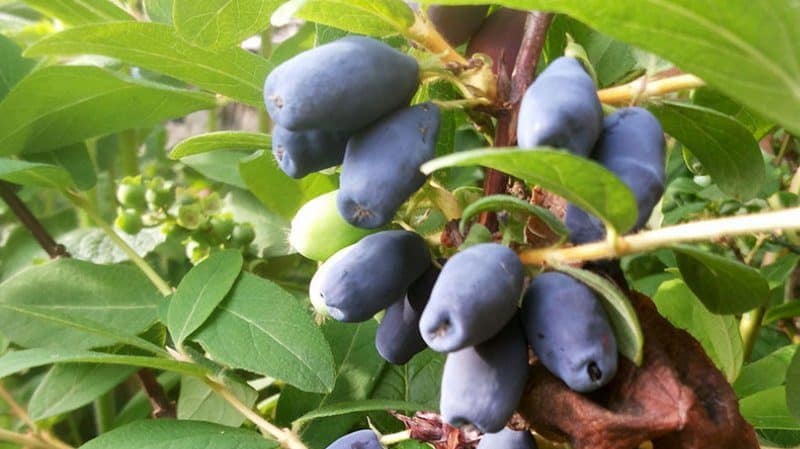
Ural honeysuckle is not inferior to southern berries in taste and commercial qualities. Next, let's look at the best varieties for growing in the Ural region.
Viola
The bush is powerful, reaches 2 m in height, the crown is dense and oval. The berries are oval-cylindrical, elongated, weighing up to 1 g. The peel is blue-violet, smooth, with a slight waxy coating. The pulp is juicy, sweet and sour, with a bitter taste.
Viola ripens together, the berries do not fall off the bush.From 2 to 3 kg of crop is harvested from one plant. The main advantages are an attractive presentation and strong immunity against diseases.
Gorlinka
An early and very sweet Gorlinka variety is popular among Ural and Siberian gardeners. The bushes are small, with a compact and neat crown - Gorlinka will decorate any garden plot.
The berries are not sour or bitter, and are distinguished by juicy and sweet pulp. The berries are large, weighing from 1 to 2 g, rich blue in color. The variety is winter-hardy, yield up to 4 kg per bush. Honeysuckle is used in cooking - jam, compotes are made, frozen or dried for the winter.
Interesting! Gorlinka honeysuckle makes a spicy and tasty sauce for meat. The berries are mixed with mint, chili pepper, garlic, herbs, apple cider vinegar and sugar. The sauce goes perfectly with pork and beef.
Cinderella
The plants are small, reaching a height of 0.7 m, semi-spreading. The weight of the berry varies from 0.7 g to 1.5 g, depending on the place of cultivation and weather conditions. The shape is elongated, the color is blue, the skin is thin with a coating.
The taste of honeysuckle is sweet, with a slight pleasant sourness and a rich berry aroma. Berries are collected from June 15, one bush yields from 2 to 4 kg. If the summer is wet and cool, then Cinderella ripens unevenly - gardeners collect the fruits gradually.
Pride of Bakchar
The variety is popular among gardeners throughout Russia. Plants are of medium height - from 1 to 1.5 m. The crown is spherical, shoots grow chaotically. The weight of the berry is about 1.4 g, the color is purple with a blue tint, the skin is dense and rough.
The pulp has a dessert and delicate taste, moderately sweet and juicy. In the first year of cultivation, about 1.5 kg of fruits are collected from the bush, in subsequent years - from 2 to 4 kg. Pride Bakchar is resistant to weather changes and rarely gets sick.The variety is valued for its balanced taste and versatility of use.
Amphora
Medium-sized bushes reach 1.5 m in height. The shoots are even, growing straight up - Amphora honeysuckle is often used for decorative purposes and used to decorate the garden plot. The weight of the berry varies from 1 g to 2 g, the color is blue-blue, with a waxy coating.
The pulp is medium dense, the taste is sweet and sour, with a slight bitterness. Advantages: transportability, rich vitamin composition, frost resistance. Productivity is about 2 kg per bush.
Amazon
Slightly spreading bushes are suitable for growing in small garden plots - they take up little space and are unpretentious in care. The weight of the fruit is about 1 g, the color is violet-blue, the shape is pitcher-shaped. The taste is sweet and sour with bitterness, the pulp is juicy, the aroma is weak.
Productivity up to 1.5 kg per plant. The berries ripen smoothly and do not fall off during the ripening period.
Lapis lazuli
The mid-early variety is resistant to heat and drought and takes root in any region. The bush is medium-sized, the shoots are strong. The berries are large - the weight of one reaches 1.5 g. The skin is purple and thin, with a slight coating.
The pulp is tender and pleasant to the taste, sweet, not bitter. Productivity - up to 2.5 kg per plant. Honeysuckle Lapis lazuli is slightly affected insect pests, differs in transportability and keeping quality.
Interesting! To get a rich harvest, it is important to water honeysuckle correctly. This is done directly at the root - the plant has a compact root system: water should irrigate all the roots. They also don’t forget about fertilizers - once a month they add a mineral complex to the soil. When the bushes grow, gardeners cut off dried branches.
cubic zirconia
Vigorous plants require a lot of space and light, so I plant them in spacious and sunny areas.The weight of the berry is about 1 g, the shape is elongated, the color is blue with a white coating. The taste is sweet and juicy, without bitterness, the aroma is moderate. From 1 sq.m I harvest about 0.3 kg of crop.
Cubic zirconia is valued for its resistance to frost, stable productivity, and attractive appearance. The berries are suitable for decorating dishes, freezing, and processing.
Early varieties of honeysuckle for the Urals
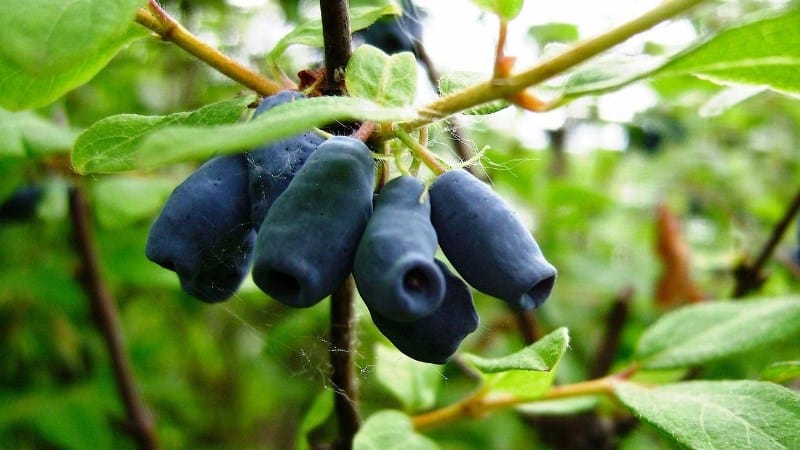
The early varieties are harvested in late May or early June. This honeysuckle is used fresh or for preparing winter preparations. Early ripening varieties do not cause trouble for gardeners and rarely get sick.
Maria
Frost-resistant productive variety. The bushes are compact and low-growing. The pulp is tasty and tender, without a sour or bitter tint. The weight of one fruit reaches 1.5 g, the shape is rounded-elongated, the color is dark purple. The aroma is rich and berry, so they like to eat honeysuckle fresh. Gardeners harvest about 1.7 kg from one bush.
Blue bird
The plants are tall, some specimens reach 1.8 m. The crown is massive, oval. The weight of the berry is about 1.2 g, the shape is oblong, the color is black and blue. The pulp is sweet and sour, pleasant to the taste.
Gardeners claim that honeysuckle tastes like Bluebird reminds me of blueberries. The skin of the fruit is thin, with a waxy coating. The yield of the variety is about 2 kg per bush; Blue Bird ripens in mid-June.
Viliga
The mid-early variety is characterized by sweet pulp and juicy taste. The bush is vigorous and requires a lot of space and light. The berries are long, up to 0.7 mm. The color is violet-blue, there is a waxy coating. The weight of honeysuckle is about 1 g, the yield is up to 2.4 kg per plant. The variety is resistant to frost and high humidity, rarely gets sick, and is unpretentious in cultivation.
Interesting! Honeysuckle is a perennial plant, so a bush can grow in one place for up to 80 years. For planting, prepare a hole 1 m x 1 m. A thick layer of drainage, for example, made of broken brick, is placed at the bottom. The seedlings are placed in a hole so that the lower branches are covered with soil. Afterwards, the honeysuckle is mulched with leaves, grass clippings, pine needles, ash or sawdust.
Mid-season varieties
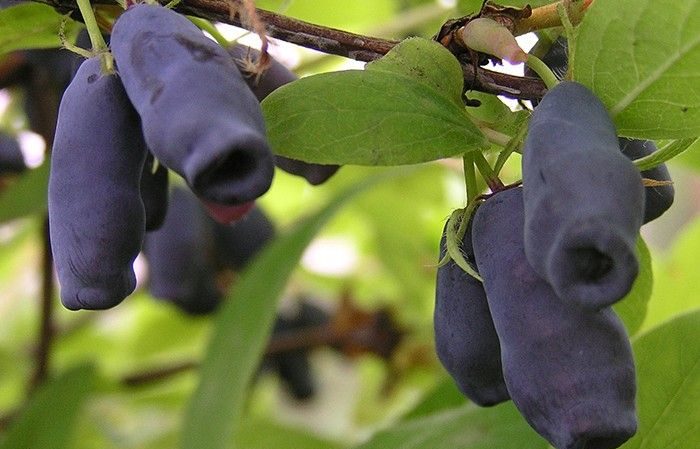
Mid-ripening varieties of honeysuckle ripen by June 20-25. It is important to choose a berry that does not fall to the ground after ripening. Let's look at popular varieties next.
Nymph
Plant height is about 1.6 m, branches are of medium length. Nymph is a frost-resistant variety that produces crops even in cold summers. The fruits are elongated, dark blue in color. The weight of the berry is about 1.2 g, the pulp is medium dense, juicy. The taste is sweet and sour, pleasant. Gardeners harvest about 2 kg of honeysuckle from one plant.
Bazhovskaya
The plant is tall and spreading, growing up to 2 m. The fruits look like small barrels - dense, slightly elongated. The weight of the berry is about 1.5 g, some specimens reach 2 g. The color is dark blue, the surface is tuberous. The taste is sweet and delicate, so the berry is used for making desserts and baking. Productivity is about 2.5 kg per plant.
Yugana
The bush is tall, about 1.7 m. The berries are black and purple, with a waxy coating. Oval shape, slightly rounded tip. The weight of the berry is about 1.6 g, the taste is dessert, with a refreshing sourness. The yield is stable - from 3 to 6 kg per bush per season.
The berries stay on the plant for up to 1.5 months and do not fall off. Suitable for long-term storage and transportation. After freezing, Yugan honeysuckle does not change its taste and retains vitamins and minerals.
Late honeysuckle for the Urals
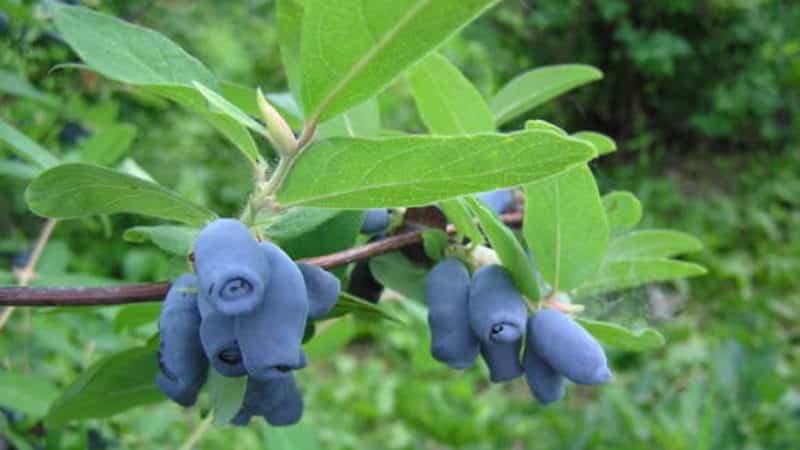
Late-ripening varieties of honeysuckle bear fruit by early or mid-July. There is an opinion that late berries are the sweetest.
Fire opal
The bushes are medium-sized, reaching a height of 1.5 g. The weight of the berry is about 1 g, the color is black and blue, with a strong waxy coating. The pulp is juicy, the taste is sweet with bitterness. The shape of the berry is round-oval, the peel is smooth. The yield of Fire Opal is stable - from 3 to 6 kg per season. The variety is resistant to fungal and viral diseases and winter-hardy.
Chosen One
The bush is tall, the crown is dense. The berries are large, each weighing about 1.2 g. The shape is oval, elongated, with a pointed tip. The color is violet-blue, the skin is thin. The chosen one is valued for its attractive presentation and sweet taste. Productivity up to 3.5 kg per bush per season.
Commonwealth
The height of the bush is up to 2 m, the shoots are powerful and spreading. The berry is oval-round, blue in color, the surface is lumpy. The weight of honeysuckle reaches 1.5 g, the taste is sweet and sour, and if there is a lack of moisture, bitterness is felt. When ripe, the berries do not fall off and are universal in use. Productivity up to 2.5 kg per season.
Other options
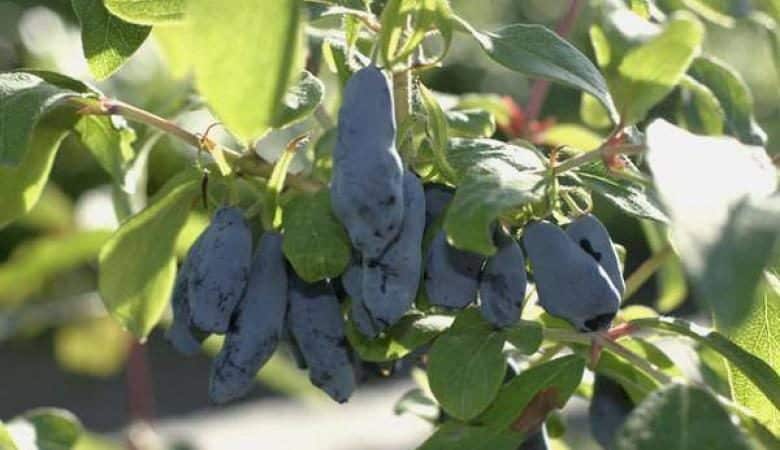
In addition to the ripening period, when choosing a variety, it is important to pay attention to the size of the berries, taste, and ability to pollinate. Large honeysuckle is used for freezing or drying, sweet honeysuckle is used for making jam or jam for the winter.
The largest
Honeysuckle is rich in vitamins and minerals, so dishes made from it are not only tasty, but also healthy. The berries are often used to prepare dietary foods and drinks - they acquire a tart taste and rich berry aroma.
- The Giant's Daughter. The weight of the berries reaches 2.5 g, the length is about 3 cm. Outwardly, such honeysuckle looks like miniature pears. The taste is sweet and juicy, without bitterness.The yield is stable - gardeners harvest up to 6 kg per season.
- Silginka. The weight of the fruit is about 1.5 g, the color is dark blue, with a waxy coating. The pulp is juicy and sweet, with a high content of vitamin C. Gardeners annually harvest up to 3 kg of berries from one plant. The variety is resistant to insect pests.
- Siberian. The frost-resistant variety is ideal for growing in the Urals. Weight is about 1.5 g, the peel is thin, blue in color. The pulp is tender, the taste is dessert, sweet and sour. One bush produces 3-4 kg of honeysuckle per season.
Self-pollinating varieties of honeysuckle
Self-pollinating varieties are varieties that do not require pollinating insects. They do not exist in honeysuckle, although many agronomists are still studying this issue and trying to develop a self-pollinating variety.
The optimal solution is to plant a berry that requires cross-pollination. It occurs with the help of insects that transfer pollen from one flower to another. It is important that these are flowers of different varieties of honeysuckle.
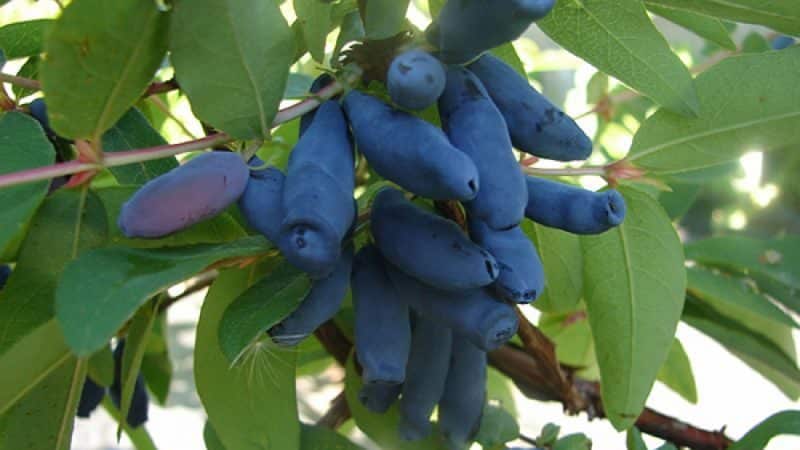
Varieties and pollinators can be the following:
- Brown and Blue Spindle;
- Blue Bird and Cinderella;
- Nymph and Pushkinskaya.
Gardeners plant these varieties next to each other. Cross-pollination and flowering of the berries occur. It is noteworthy that this method of growing is considered one of the most effective.
The sweetest
Sweet varieties love moderate moisture, balanced fertilizing, loose and fertile soil. Such berries are suitable for fresh consumption — adults and children love them.
The pulp should be juicy and tender, with a sweet taste.
- Viola. The weight of the berry is about 1 g, the shape is elongated. The color is dark purple, sometimes black. The variety is resistant to insects and pests, the yield is about 1.5 kg per bush.
- My joy. Weight about 1.2 g, dessert pulp, without bitterness. My joy ripens by the beginning of July, gardeners use the harvest to prepare preparations. To obtain a rich harvest, it is recommended to fertilize honeysuckle with mineral fertilizers.
- Martin. The berry weighs about 1.5 g, the taste is very sweet. Ripen by mid-June, frost-resistant. Plants are unpretentious in care. Productivity is about 0.5 kg per 1 sq.m. The Lastochka variety has a pleasant berry aroma.
How to choose a variety - expert recommendations
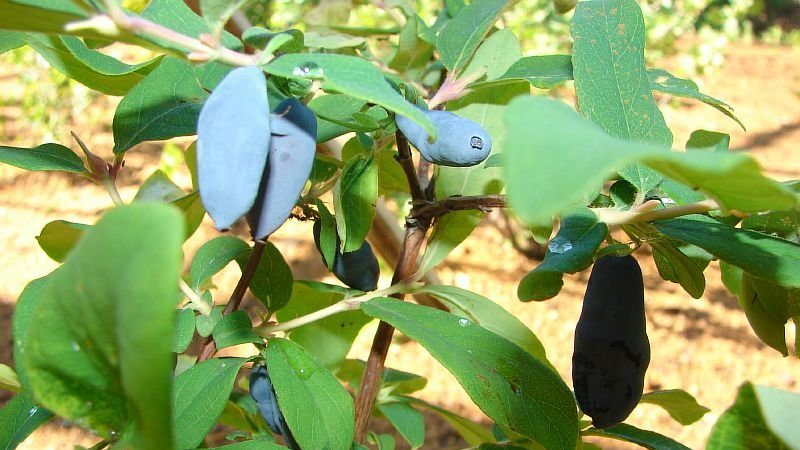
Frost-resistant varieties are chosen for planting in the Urals. Seedlings must be strong, the recommended age is no more than two years. Pay attention to the branches - they should be flexible, not dry, without bends or cracks. It is important to check with the seller in what year the honeysuckle will bear fruit.
Gardeners also take into account the following characteristics when purchasing:
- taste qualities;
- productivity;
- care requirements;
- crumbling;
- resistance to diseases and pests.
If honeysuckle is chosen for decorative purposes, then no attention is paid to taste and yield - the height and size of the bush, foliage, and crown play a role. If the berries are used for culinary purposes, then on the contrary, they do not look at the height of the tree; only the taste characteristics and yield are important.
Conclusion
Honeysuckle is a garden decoration and a source of vitamins and minerals. The berries are distinguished by their bizarre shape and appetizing blue-violet hue. For the Urals, the varieties chosen are Viola, Izbrannitsa, Blue Bird, and Commonwealth.
Before buying a seedling, pay attention to its appearance, description of the variety and reviews of other gardeners. Honeysuckle is planted in dry and nutritious soils, after digging a hole and placing a small stone on the bottom.Honeysuckle is unpretentious in care, but it is important to follow the watering schedule and trim dry and weak branches in a timely manner.